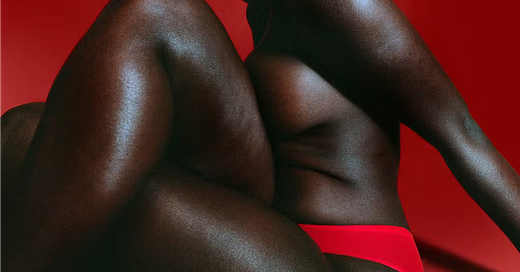Hello and welcome to another edition of THE DON’T BUY LIST!
Naomi Watts — actress and founder of Stripes, a beauty brand made for menopausal people — is writing a book: Dare I Say It: Everything I Wish I’d Known About Menopause. I wonder if there’ll be a chapter that covers how easy it is to convince a vulnerable demographic suffering from a lack of medical research to buy more wrinkle-reducing moisturizer… Which reminds me! Remember the blind item I posted last year? “Which celebrity’s team booked me as a guest on the celebrity’s forthcoming podcast without mentioning said celebrity was set to launch a skincare line soon — thus sort of duping me into endorsing a celebrity beauty brand despite my well-established anti-celebrity-beauty-brand stance?” It was Watts’s team (at a company that no longer owns Stripes). Here’s the unaired interview.
Anyway! Onto the links.
IN THIS ISSUE: Skin dysmorphia! Dollcore beauty! The meaninglessness of “clinically proven”! Hotties For Harris! Sabrina Carpenter! Beef fat in moisturizer! The Lipstick Effect is dead! The Perfume Effect is born! Dissolving filler! Getting face lifts! Crème de You! Godly dentistry! Annie Ernaux on ugliness! Micro-insecurities! & more!
YOUR FACE IS FINE: I spoke to Serena Smith of Dazed for “Skin dysmorphia: Why your skin is probably better than you think.”
“‘When a particular beauty trend or beauty standard becomes the norm, it can affect our perception of ourselves,’ says DeFino. It’s a phenomenon known as ‘perception drift’. ‘We can begin to see our normal, non-product enhanced faces as abnormal, and an abnormal amount of product – whether blush, brow pencil, ‘glazing fluid’, or Botox – as ideal.’ She adds that terms like ‘blush blindness’ can downplay the gravity of this issue. ‘It’s dysmorphia – an inability to see ourselves as we are.’”
The whole article is worth a read!
REALITY BITES: The above situation isn’t getting any help from Charlotte Tilbury. The brand calls its new base the “Unreal Skin Foundation Stick” and it apparently had a 15,000-person waitlist pre-launch.
CLINICALLY UNPROVEN: “Don’t fall for ‘clinically proven’ beauty products,” journalist Sara Radin warns. I was delighted when Radin asked to interview me about meaningless marketing terms, science-washing, and the limits of the FDA’s regulation of language. An excerpt:
“It’s not just the language on our beauty product packaging that you need to watch out for. As consumers, we should also be alert to the medicalisation of beauty standards themselves, DeFino says, as it’s often used by brands and even dermatologists as a way to legitimise ideals that are based on aesthetics rather than health and function. Her concern is that this so-called ‘science’ is being used to promote an ageist, inhuman, unattainable standard of beauty that is actually scientifically proven to contribute to increased instances of appearance-related anxiety, depression and dysmorphia.
“She points to a page on beauty retailer Sephora’s website for ‘clinical and dermatological skincare’. Some of the ‘problems’ that Sephora claims to target ‘clinically’ include pores, texture and wrinkles. However, pores, texture and wrinkles are not problems – they are basic human features. ‘We do not need science to save us from pores, texture, or wrinkles. They are not necessarily signs of unhealthy or non-functioning skin,’ DeFino says. ‘They come with the territory of being alive.’
Read the full story here.
DOLL FACE: I also spoke to Radin for this piece on “dollcore” beauty in Highsnobiety.
THE DISSOLUTION SOLUTION: Lots of people talking about celebrities dissolving their fillers (Kylie Jenner, Paige Lorenze, Olivia Culpo); not a lot of people connecting that to a recent press release from the American Academy of Facial Plastic and Reconstructive Surgery:



